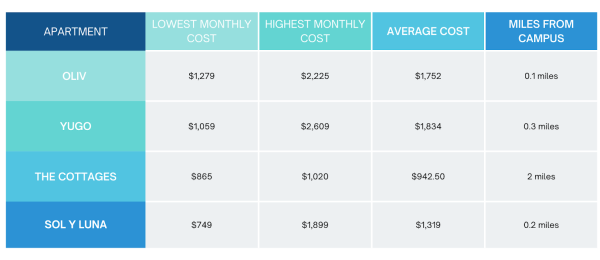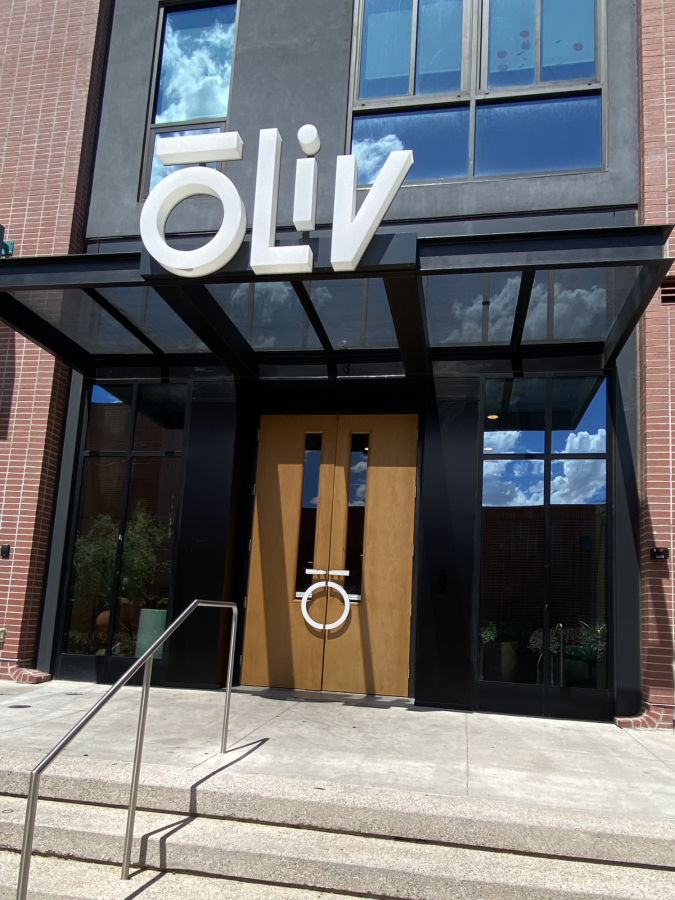An entrance to the Oliv Tucson apartment complex located on 900 E. 2nd St. Oliv is west of campus and is home to many University of Arizona students.
In the year 2000, the average price of a home was $119,600. Today, the average cost is $416,100. That is a 247.91% increase.
It is commonly known that the United States is in a housing crisis. This includes being short on homes as well as the fact that the homes that do exist are too expensive for many people. Additionally, according to PBS, the cost of rent is rising right alongside home prices.
So, the cost of homes and rent are increasing all across the nation, but what does this mean?
Aside from the obvious and worst-case consequence, homelessness, there is a cascade of other impacts.
According to the National Library of Medicine, some of the effects include lower productivity in the workplace due to workers’ need to work longer hours and pick up other jobs to stay afloat financially. The stress related to a lack of housing can lead to physical and mental ailments as well. This issue demands medical attention which demands, you guessed it, more money.
People across the nation are struggling, and the state of Arizona is no exception. As stated in the Wise Voter, Arizona is the ninth fastest-growing state in the nation. The influx of people calls for a rise in housing, however, when those homes are unaffordable, people are not left with many options.
A student-geared apartment complex near campus called Aspire includes on their website that as of 2022 the UA’s main campus was “home to over 39,000 students”.
The nation and the state of Arizona are experiencing a housing crisis and Tucson is feeling the heat too.
Students at the UA’s living situations can be broken down into a couple of main groups; students living in campus housing, those living off campus or living at home. There are, of course, outliers.
Focusing mainly on how students are impacted by the housing crisis, those living on campus and off campus are of particular interest.
The cheapest dorms at the UA for shared occupancy cost $6,750 for the academic year. The most expensive dorms at the UA for shared occupancy cost $9,610. The prices for single-person dorms differ and can reach up to $14,410 for the academic year. If these dorms were paid monthly, from August to May, this hypothetical rent (excluding single rooms) would be $818 on average.
Apartments off campus but for students include places like Oliv, Yugo, Sol y Luna, The Cottages, etc.

The cost of off-campus student living is high as well. To put these numbers into perspective, cheaper apartments in San Francisco cost around $2,000 a month, and in Phoenix the average monthly rent is $1,553.
To live a reasonable distance from campus, or to live on campus, students are at the hands of the current skyrocketing prices the nation is facing.
For students funding their own education, this is a big issue.
An interesting caveat of student housing is that of Resident Assistants. RAs get to live on campus for free, so long as they complete their training, work their hours and fulfill their duties. While on a surface level this seems like a great gig, there are a few other factors to consider here.
There is a non-traditional paycheck, and in addition, RAs can only work 10 (15 with approval) hours on campus in addition to their RA job. Part of the decision to be an RA is obviously role centered, but the financial help it provides is considerable if not of equal importance.
So, students can avoid the burden of high housing costs by being an RA but then are limited in other ways; this can mean socially, monetarily and time wise.
Students are grateful for the RA role as well as the price of on-campus housing, but they wouldn’t be in a position of need if the states’ and nation’s housing options were affordable in the first place. Essentially, because of the housing crisis, students can resort to other solutions but this would not need to be done if housing was affordable in the first place. It is like thanking a doctor for medicine if it was the doctor that made you ill to begin with.
This college campus is a version of the world students will be entering after they leave college. If an off-campus apartment is barely attainable, how is living after college going to look?
Students are vulnerable in the face of the housing crisis, and their states, cities and institutions need to step up.
Follow the Daily Wildcat on Instagram and Twitter (X)

Olivia Malone is a UA student studying law and journalism, and minoring in family studies and human development. She enjoys being outdoors, making music, and traveling.









